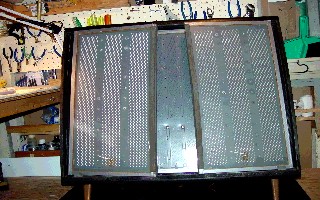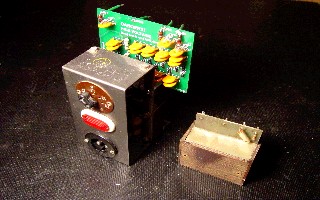click on any pic to download a ~2MB huge a hi-rez photo
|
This image shows the ESL-57's bass panels slid partially out of their bed in the speaker's frame, sufficient to permit the removal of the treble panel.
|

|

|
This image shows the ESL-57 with the treble panel removed.
|
|
This image shows the treble panel with its dustcovers removed.
|

|

|
This image shows the tools I use to remove the rivets from the treble panel.
|

|
This image shows the arc burn on the diaphragm and on the interior of the rear stator, to which the diaphragm is bonded.
|
|
This image shows the diaphragm removed from the stator, and the hole burnt in the diaphragm and on the interior of the stator.
|

|

|
This image shows the interior of the stator panel after it has been repaired. I cannot find a shade of grey that matches Quad's original colour exactly.
|
|
This image shows two thin strips of copper foil leading from the two holes where the EHT wire is connected to the two bolts which feed high-tension charge to the diaphragm. These strips improve the transfer of the charge to the diaphragm. A later image ( EHTfoil2.jpg ) shows the copper strips projecting on the outside of the panel, in direct contact with the EHT bolt. This self-adhesive copper foil can be bought at any store selling stained-glass supplies. The foil is so thin that it has a negligible impact on the stator-to-diaphragm gap. In fact, any Quad panel with a few loose rivets would probably have a greater gap.
|

|

|
This image shows the tensioned diaphragm in the stretching jig laid over a stator panel, for the purpose of masking the diaphragm prior to coating.
|
|
This image shows the masked and tensioned diaphragm prior to coating.
|

|

|
This image shows rear stator panel being bonded to the diaphragm.
|
|
This image shows rear stator panel after it has been bonded to the diaphragm.
|

|
|
This is another image of the diaphragm with bolt pass-through holes in it.
|

|
|
This image shows the rebuilt treble panel with its dustcovers replaced.
|

|

|
This image shows a Quad rectifier unit with its original EHT block, and the replacement Enquist EHT unit alongside it.
|
|
This image shows a Quad rectifier unit with a replacement Enquist EHT unit installed, and the original Quad EHT block alongside it.
|

|

|
This image shows the rebuilt ESL-57 from the rear, prior to replacing damping mats and rear grill.
|
|
This image shows the rebuilt ESL-57 from the front, prior to replacing the front grill.
|

|













